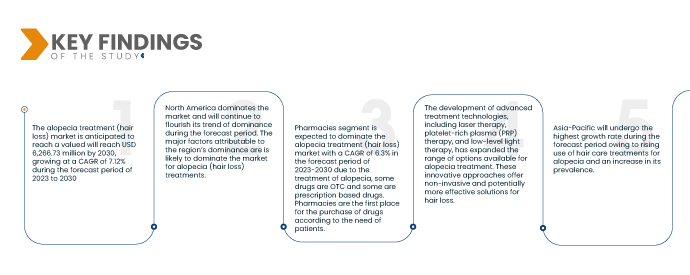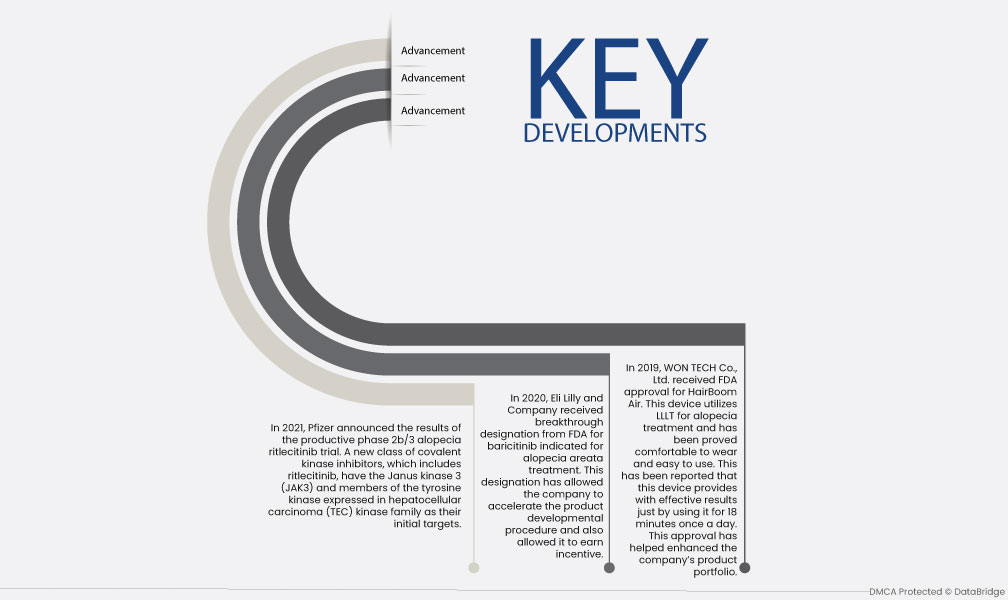Глобальный рынок лечения алопеции (выпадения волос) переживает значительный рост из-за растущей распространенности состояний потери волос, повышения осведомленности о доступных вариантах лечения и достижений в области технологий. Алопеция может поражать людей всех возрастов и полов, приводя к эмоциональному стрессу и отрицательному влиянию на самооценку. Рынок предлагает различные подходы к лечению, включая медикаменты, хирургические процедуры и методы пересадки волос. С акцентом на улучшение роста волос и восстановление уверенности рынок лечения алопеции продолжает развиваться, предлагая решения для людей, страдающих от потери волос.
Доступ к полному отчету по адресу https://www.databridgemarketresearch.com/reports/global-alopecia-treatment-hair-loss-market
Data Bridge Market Research анализирует, что рынок лечения алопеции (выпадения волос) оценивается и достигнет 6 266,73 млн долларов США к 2030 году, увеличившись на среднегодовой темп роста 7,12% в прогнозируемый период с 2023 по 2030 год. Растущая распространенность состояний потери волос, таких как андрогенетическая алопеция, гнездная алопеция и тракционная алопеция, является основным драйвером для мирового рынка лечения алопеции. Растущее число людей, страдающих от потери волос, подпитывает спрос на эффективные варианты лечения.
Основные выводы исследования
Ожидается, что рост численности гериатрического населения будет способствовать темпам роста рынка.
Рост численности гериатрического населения во всем мире привел к увеличению спроса на лечение алопеции. По мере того, как люди стареют, они часто сталкиваются с возрастной потерей волос, что может повлиять на их внешний вид и самооценку. Многие пожилые люди мотивированы искать эффективные варианты лечения, чтобы решить эту проблему и сохранить более молодой вид. Это растущее желание бороться с возрастной потерей волос обусловило спрос на лечение алопеции среди пожилого населения.
Область отчета и сегментация рынка
Отчет Метрика
|
Подробности
|
Прогнозируемый период
|
2023-2030
|
Базовый год
|
2022
|
Исторические годы
|
2021 (Можно настроить на 2015-2020)
|
Количественные единицы
|
Доход в млн. долл. США, объемы в единицах, цены в долл. США
|
Охваченные сегменты
|
Тип заболевания ( гнездная алопеция , рубцовая, тракционная, андрогенетическая алопеция, нерубцовая алопеция, тракционная алопеция, циатрическая алопеция, тотальная алопеция, универсальная алопеция и другие), лечение (локализованная терапия, медицинские приборы, системная терапия, лечение травами, услуги по пересадке волос, низкоуровневая лазерная терапия), тип препарата (местные средства, пероральные препараты, инъекции, кортикостероиды, иммунодепрессанты, миноксидил, финастерид и другие), пол (мужской, женский), возрастная группа (младше 18 лет, 18–34 года, 35–49 лет, старше 50 лет), форма (местная, пероральная, парентеральная), канал распространения (больничная аптека, аптеки, дерматологические клиники, розничная аптека, интернет-аптека и другие), конечные пользователи (Больницы, дерматологические и трихологические клиники, эстетические клиники, специализированные клиники, уход на дому, другие)
|
Страны, охваченные
|
США, Канада и Мексика в Северной Америке, Германия, Франция, Великобритания, Нидерланды, Швейцария, Бельгия, Россия, Италия, Испания, Турция, Остальная Европа в Европе, Китай, Япония, Индия, Южная Корея, Сингапур, Малайзия, Австралия, Таиланд, Индонезия, Филиппины, Остальная часть Азиатско-Тихоокеанского региона (APAC) в Азиатско-Тихоокеанском регионе (APAC), Саудовская Аравия, ОАЭ, Южная Африка, Египет, Израиль, Остальной Ближний Восток и Африка (MEA) как часть Ближнего Востока и Африки (MEA), Бразилия, Аргентина и Остальная часть Южной Америки как часть Южной Америки.
|
Охваченные участники рынка
|
Johnson & Johnson Private Limited (США), GSK plc (Великобритания), Merck & Co., Inc. (США), Pfizer Inc. (США), Sun Pharmaceutical Industries Ltd. (Индия), Teva Pharmaceutical Industries Ltd. (Израиль), Cipla Inc. (США), Endo International plc (Ирландия), Zydus Group (Индия), Abbott (США), Aurobindo Pharma (Индия); Reddy's Laboratories Ltd. (Индия), Perrigo Company plc (Ирландия), Curallux, LLC. (США), Д-Р. KURT WOLFF GMBH & CO. KG (Германия), WOCKHARDT (Индия), Sun Pharmaceutical Industries Ltd. (Индия), Concert Pharmaceuticals. (США), Cipla Inc. (Индия), DAIICHI SANKYO COMPANY, LIMITED. (Япония) среди прочих
|
Данные, отраженные в отчете
|
Помимо аналитических данных о рыночных сценариях, таких как рыночная стоимость, темпы роста, сегментация, географический охват и основные игроки, рыночные отчеты, подготовленные Data Bridge Market Research, также включают в себя углубленный экспертный анализ, эпидемиологию пациентов, анализ воронки продаж, анализ ценообразования и нормативную базу.
|
Анализ сегмента:
Рынок средств для лечения алопеции (выпадения волос) сегментирован по типу заболевания, лечению, полу, форме, конечным пользователям и каналу сбыта.
- На основе типа заболевания мировой рынок лечения алопеции (выпадения волос) сегментируется на нерубцовую алопецию, тракционную алопецию, циатрическую алопецию и другие. Ожидается, что сегмент нерубцовой алопеции будет доминировать на рынке с долей рынка 54,80% в прогнозируемый период 2023-2030 гг., поскольку это наиболее распространенный тип алопеции, который поражает большую часть населения.
Ожидается , что в 2023 году сегмент нерубцовой алопеции будет доминировать на рынке в сегменте заболеваний
Ожидается, что в 2023 году сегмент нерубцовой алопеции будет доминировать на рынке, поскольку это наиболее распространенный тип алопеции, который поражает большую часть населения. Андрогенетическая алопеция является повседневной причиной потери волос как у мужчин, так и у женщин. Эта форма потери волос затрагивает прогнозируемо 50 миллионов мужчин и 30 миллионов женщин с долей рынка 54,80% в прогнозируемый период 2023-2030 гг.
- На основе лечения глобальный рынок лечения алопеции (выпадения волос) сегментируется на локализованную терапию, медицинские устройства, системную терапию и лечение травами. Ожидается, что сегмент локализованной терапии будет доминировать на рынке лечения алопеции (выпадения волос) с CAGR 6,6% в прогнозируемый период 2023-2030 гг., поскольку локализованная терапия является терапией первой линии, и если новый рост волос происходит от инъекций кортикостероидов, как правило, он виден в течение четырех недель. Эти типы терапии считаются простыми в использовании и имеют минимальные побочные эффекты.
- По половому признаку глобальный рынок лечения алопеции (выпадения волос) сегментируется на мужской и женский. Ожидается, что мужской сегмент будет доминировать на рынке лечения алопеции (выпадения волос) с CAGR 6,6% в прогнозируемый период 2023-2030 гг., поскольку, по данным Национальной медицинской библиотеки США и Американской ассоциации по борьбе с выпадением волос, почти 50% мужчин испытывают некоторую степень выпадения волос к 50 годам. Андроген является основной причиной андрогенной алопеции у мужчин.
- На основе формы глобальный рынок лечения алопеции (выпадения волос) сегментируется на местный, пероральный и парентеральный. Ожидается, что местный сегмент будет доминировать на рынке лечения алопеции (выпадения волос) с долей рынка 49,46% в прогнозируемый период 2023-2030 гг. из-за низкого риска системных побочных эффектов и взаимодействия лекарственных средств.
Ожидается, что в 2023 году сегмент топических средств будет доминировать над сегментом форм на рынке лечения алопеции (выпадения волос).
Ожидается, что в 2023 году сегмент средств местного применения будет доминировать на рынке лечения алопеции (выпадения волос) из-за низкого риска системных побочных эффектов и взаимодействия с лекарственными средствами, а приблизительно у 40–50 % пациентов, проходящих лечение средствами местного применения, волосы на голове восстановятся примерно через шесть месяцев лечения, что составит 49,46 % доли рынка в прогнозируемый период 2023–2030 годов.
- На основе конечных пользователей глобальный рынок лечения алопеции (выпадения волос) сегментируется на дерматологические центры, больницы и домашнее здравоохранение. Ожидается, что сегмент дерматологических центров будет доминировать на рынке лечения алопеции (выпадения волос) с долей 6,2% в прогнозируемый период 2023-2030 гг. за счет наличия в дерматологических центрах специализированных специалистов и растущей распространенности алопеции и восстановительных операций в сочетании с широким применением рецептурных препаратов.
- На основе канала сбыта глобальный рынок лечения алопеции (выпадения волос) сегментируется на аптеки, розничные продажи и прямые торги. Ожидается, что сегмент аптек будет доминировать на рынке лечения алопеции (выпадения волос) с CAGR 6,3% в прогнозируемый период 2023-2030 гг. из-за лечения алопеции, некоторые препараты являются безрецептурными, а некоторые - рецептурными. Аптеки являются первым местом для закупки лекарств в соответствии с потребностями пациентов.
Основные игроки
Data Bridge Market Research признает следующие компании основными игроками на рынке лечения алопеции (выпадения волос): Johnson & Johnson Private Limited (США), GSK plc (Великобритания), Merck & Co., Inc. (США), Pfizer Inc. (США), Sun Pharmaceutical Industries Ltd. (Индия), Teva Pharmaceutical Industries Ltd. (Израиль), Cipla Inc. (США), Endo International plc (Ирландия), Zydus Group (Индия), Abbott (США), Aurobindo Pharma (Индия)
Развитие рынка
- В 2021 году компания Pfizer объявила о результатах продуктивного исследования алопеции ритлецитиниба фазы 2b/3. Новый класс ингибиторов ковалентной киназы, включающий ритлецитиниб, имеет в качестве своих первоначальных целей янус-киназу 3 (JAK3) и членов семейства тирозинкиназ, экспрессируемых в гепатоцеллюлярной карциноме (TEC).
- В 2020 году компания Eli Lilly and Company получила от FDA статус прорывного препарата барицитиниб, предназначенного для лечения гнездной алопеции. Этот статус позволил компании ускорить процедуру разработки продукта, а также получить поощрения.
- В 2019 году компания WON TECH Co., Ltd. получила одобрение FDA на HairBoom Air. Это устройство использует LLLT для лечения алопеции и доказало свою удобство в ношении и простоту использования. Сообщается, что это устройство обеспечивает эффективные результаты, если использовать его всего 18 минут один раз в день. Это одобрение помогло расширить ассортимент продукции компании.
Региональный анализ
Географически в отчете о рынке лечения алопеции (выпадения волос) рассматриваются следующие страны: США, Канада и Мексика в Северной Америке, Германия, Франция, Великобритания, Нидерланды, Швейцария, Бельгия, Россия, Италия, Испания, Турция, остальные страны Европы в Европе, Китай, Япония, Индия, Южная Корея, Сингапур, Малайзия, Австралия, Таиланд, Индонезия, Филиппины, остальные страны Азиатско-Тихоокеанского региона (APAC) в Азиатско-Тихоокеанском регионе (APAC), Саудовская Аравия, ОАЭ, Южная Африка, Египет, Израиль, остальные страны Ближнего Востока и Африки (MEA) как часть Ближнего Востока и Африки (MEA), Бразилия, Аргентина и остальные страны Южной Америки как часть Южной Америки.
Согласно анализу Data Bridge Market Research:
Северная Америка является доминирующим регионом на рынке лечения алопеции (выпадения волос) в прогнозируемый период 2023-2030 гг.
Северная Америка доминирует на рынке и продолжит процветать в своей тенденции доминирования в течение прогнозируемого периода. Распространенная форма алопеции и последствия, которые испытывают люди с алопецией, стимулировали региональный рынок. Однако основным драйвером роста регионального рынка является рынок, который расширяется и привлекает новых конкурентов.
По оценкам, Азиатско-Тихоокеанский регион станет самым быстрорастущим регионом на рынке лечения алопеции (выпадения волос) в прогнозируемый период 2023–2030 гг.
Азиатско-Тихоокеанский регион будет испытывать самые высокие темпы роста в течение прогнозируемого периода из-за растущего использования средств по уходу за волосами при алопеции и увеличения ее распространенности. Более того, ожидается, что улучшение сценария регулирования здравоохранения в развивающихся странах привлечет международных игроков к инвестированию и использованию имеющихся рыночных возможностей
Для получения более подробной информации об отчете о рынке лечения алопеции (выпадения волос) нажмите здесь – https://www.databridgemarketresearch.com/reports/global-alopecia-treatment-hair-loss-market












